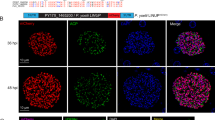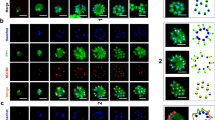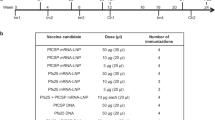Abstract
Malaria continues to devastate sub-Saharan Africa owing to the emergence of drug resistance to established antimalarials and to the lack of an efficacious vaccine. Plasmodium species have a unique streamlined purine pathway in which the dual specificity enzyme purine nucleoside phosphorylase (PNP) functions in both purine recycling and purine salvage1,2,3,4. To evaluate the importance of PNP in an in vivo model of malaria, we disrupted PyPNP, the gene encoding PNP in the lethal Plasmodium yoelii YM strain. P. yoelii parasites lacking PNP were attenuated and cleared in mice. Although able to form gametocytes, PNP-deficient parasites did not form oocysts in mosquito midguts and were not transmitted from mosquitoes to mice. Mice given PNP-deficient parasites were immune to subsequent challenge to a lethal inoculum of P. yoelii YM and to challenge from P. yoelii 17XNL, another strain. These in vivo studies with PNP-deficient parasites support purine salvage as a target for antimalarials. They also suggest a strategy for the development of attenuated nontransmissible metabolic mutants as blood-stage malaria vaccine strains.
This is a preview of subscription content, access via your institution
Access options
Subscribe to this journal
Receive 12 print issues and online access
$259.00 per year
only $21.58 per issue
Buy this article
- Purchase on SpringerLink
- Instant access to full article PDF
Prices may be subject to local taxes which are calculated during checkout

Similar content being viewed by others
References
Kicska, G.A. et al. Transition state analogue inhibitors of purine nucleoside phosphorylase from Plasmodium falciparum. J. Biol. Chem. 277, 3219–3225 (2002).
Kicska, G.A. et al. Purine-less death in Plasmodium falciparum induced by immucillin-H, a transition state analogue of purine nucleoside phosphorylase. J. Biol. Chem. 277, 3226–3231 (2002).
Shi, W. et al. Plasmodium falciparum purine nucleoside phosphorylase: crystal structures, immucillin inhibitors and dual catalytic function. J. Biol. Chem. 279, 18103–18106 (2004).
Ting, L.M. et al. Targeting a novel Plasmodium falciparum purine recycling pathway with specific immucillins. J. Biol. Chem. 280, 9547–9554 (2005).
Snow, R., Craig, M., Deichmann, U. & Marsh, K. Estimating mortality, morbidity and disability due to malaria among Africa's non-pregnant population. Bull. World Health Organ. 77, 624–640 (1999).
Reyes, P. et al. Enzymes of purine and pyrimidine metabolism from the human malaria parasite, Plasmodium falciparum. Mol. Biochem. Parasitol. 5, 275–290 (1982).
Muller, S. et al. In the human malaria parasite Plasmodium falciparum, polyamines are synthesized by a bifunctional ornithine decarboxylase, S-adenosylmethionine decarboxylase. J. Biol. Chem. 275, 8097–8102 (2000).
Muller, S., Coombs, G.H. & Walter, R.D. Targeting polyamines of parasitic protozoa in chemotherapy. Trends Parasitol. 17, 242–249 (2001).
Wrenger, C., Luersen, K., Krause, T., Muller, S. & Walter, R.D. The Plasmodium falciparum bifunctional ornithine decarboxylase, S-adenosyl-l-methionine decarboxylase, enables a well balanced polyamine synthesis without domain-domain interaction. J. Biol. Chem. 276, 29651–29656 (2001).
Burkot, T.R., Graves, P.M., Paru, R., Wirtz, R.A. & Heywood, P.F. Human malaria transmission studies in the Anopheles punctulatus complex in Papua New Guinea: sporozoite rates, inoculation rates and sporozoite densities. Am. J. Trop. Med. Hyg. 39, 135–144 (1988).
Weiss, W.R., Good, M.F., Hollingdale, M.R., Miller, L.H. & Berzofsky, J.A. Genetic control of immunity to Plasmodium yoelii sporozoites. J. Immunol. 143, 4263–4266 (1989).
Weiss, W.R. Host-parasite interactions and immunity to irradiated sporozoites. Immunol. Lett. 25, 39–42 (1990).
Khan, Z.M. & Vanderberg, J.P. Role of host cellular response in differential susceptibility of nonimmunized BALB/c mice to Plasmodium berghei and Plasmodium yoelii sporozoites. Infect. Immun. 59, 2529–2534 (1991).
Hoffman, S.L. et al. Immune response gene regulation of immunity to Plasmodium berghei sporozoites and circumsporozoite protein vaccines. Overcoming genetic restriction with whole organism and subunit vaccines. J. Immunol. 142, 3581–3584 (1989).
Mota, M.M., Thathy, V., Nussenzweig, R.S. & Nussenzweig, V. Gene targeting in the rodent malaria parasite Plasmodium yoelii. Mol. Biochem. Parasitol. 113, 271–278 (2001).
Jongco, A.M., Ting, L.M., Thathy, V., Mota, M.M. & Kim, K. Improved transfection and new selectable markers for the rodent malaria parasite Plasmodium yoelii. Mol. Biochem. Parasitol. 146, 242–250 (2006).
Ecker, A., Moon, R., Sinden, R.E. & Billker, O. Generation of gene targeting constructs for Plasmodium berghei by a PCR-based method amenable to high throughput applications. Mol. Biochem. Parasitol. 145, 265–268 (2006).
Kadekoppala, M., Kline, K., Akompongm, T. & Haldar, K. Stable expression of a new chimeric fluorescent reporter in the human malaria parasite Plasmodium falciparum. Infect. Immun. 68, 2328–2332 (2000).
Menard, R. et al. Circumsporozoite protein is required for development of malaria sporozoites in mosquitoes. Nature 385, 336–340 (1997).
Wykes, M. & Good, M.F. A case for whole-parasite malaria vaccines. Int. J. Parasitol. 37, 705–712 (2007).
Hoffman, S.L. et al. Protection of humans against malaria by immunization with radiation-attenuated Plasmodium falciparum sporozoites. J. Infect. Dis. 185, 1155–1164 (2002).
Luke, T.C. & Hoffman, S.L. Rationale and plans for developing a non-replicating, metabolically active, radiation-attenuated Plasmodium falciparum sporozoite vaccine. J. Exp. Biol. 206, 3803–3808 (2003).
Mueller, A.K., Labaied, M., Kappe, S.H. & Matuschewski, K. Genetically modified Plasmodium parasites as a protective experimental malaria vaccine. Nature 433, 164–167 (2005).
Makobongo, M.O. et al. The purine salvage enzyme hypoxanthine guanine xanthine phosphoribosyl transferase is a major target antigen for cell-mediated immunity to malaria. Proc. Natl. Acad. Sci. USA 100, 2628–2633 (2003).
Pombo, D.J. et al. Immunity to malaria after administration of ultra-low doses of red cells infected with Plasmodium falciparum. Lancet 360, 610–617 (2002).
Sambandamurthy, V.K. & Jacobs, W.R., Jr. Live attenuated mutants of Mycobacterium tuberculosis as candidate vaccines against tuberculosis. Microbes Infect. 7, 955–961 (2005).
Scheller, L.F. & Azad, A.F. Maintenance of protective immunity against malaria by persistent hepatic parasites derived from irradiated sporozoites. Proc. Natl. Acad. Sci. USA 92, 4066–4068 (1995).
Bejon, P. et al. Calculation of liver-to-blood inocula, parasite growth rates, and preerythrocytic vaccine efficacy, from serial quantitative polymerase chain reaction studies of volunteers challenged with malaria sporozoites. J. Infect. Dis. 191, 619–626 (2005).
El Bissati, K. et al. The plasma membrane permease PfNT1 is essential for purine salvage in the human malaria parasite Plasmodium falciparum. Proc. Natl. Acad. Sci. USA 103, 9286–9291 (2006).
Sultan, A.A. et al. TRAP is necessary for gliding motility and infectivity of Plasmodium sporozoites. Cell 90, 511–522 (1997).
Acknowledgements
This work was supported by US National Institutes of Health grant R21AI052469 and US Army Research Grant W81XWH-05-2-0025 (both to K.K.). P.S. and A.C. were supported by US National Institutes of Health grant R01 AI056840. We gratefully thank V. Schramm for review of the manuscript before submission, J. Nonon and S. Gonzalez for technical support during mosquito rearing and infection, V. Lagal for advice on PCR and A. Mwakingwe for assistance with sporozoite challenge experiments. We also thank V. Schramm for advice on biochemical assays and many stimulating discussions during the course of this work.
Author information
Authors and Affiliations
Contributions
L.-M.T., M.G. and A.C. performed experiments. L.-M.T., P.S. and K.K. planned experiments and analyzed data. L.-M.T. and K.K. wrote the manuscript.
Corresponding author
Supplementary information
Supplementary Text and Figures
Supplementary Figs. 1–4, Supplementary Table 1 and Supplementary Methods (PDF 452 kb)
Rights and permissions
About this article
Cite this article
Ting, LM., Gissot, M., Coppi, A. et al. Attenuated Plasmodium yoelii lacking purine nucleoside phosphorylase confer protective immunity. Nat Med 14, 954–958 (2008). https://doi.org/10.1038/nm.1867
Received:
Accepted:
Published:
Issue date:
DOI: https://doi.org/10.1038/nm.1867
This article is cited by
-
Immunological memory to blood-stage malaria infection is controlled by the histamine releasing factor (HRF) of the parasite
Scientific Reports (2017)
-
Disruption of plasmepsin-4 and merozoites surface protein-7 genes in Plasmodium berghei induces combined virulence-attenuated phenotype
Scientific Reports (2011)
-
Disarming the malaria parasite
Nature Medicine (2008)



